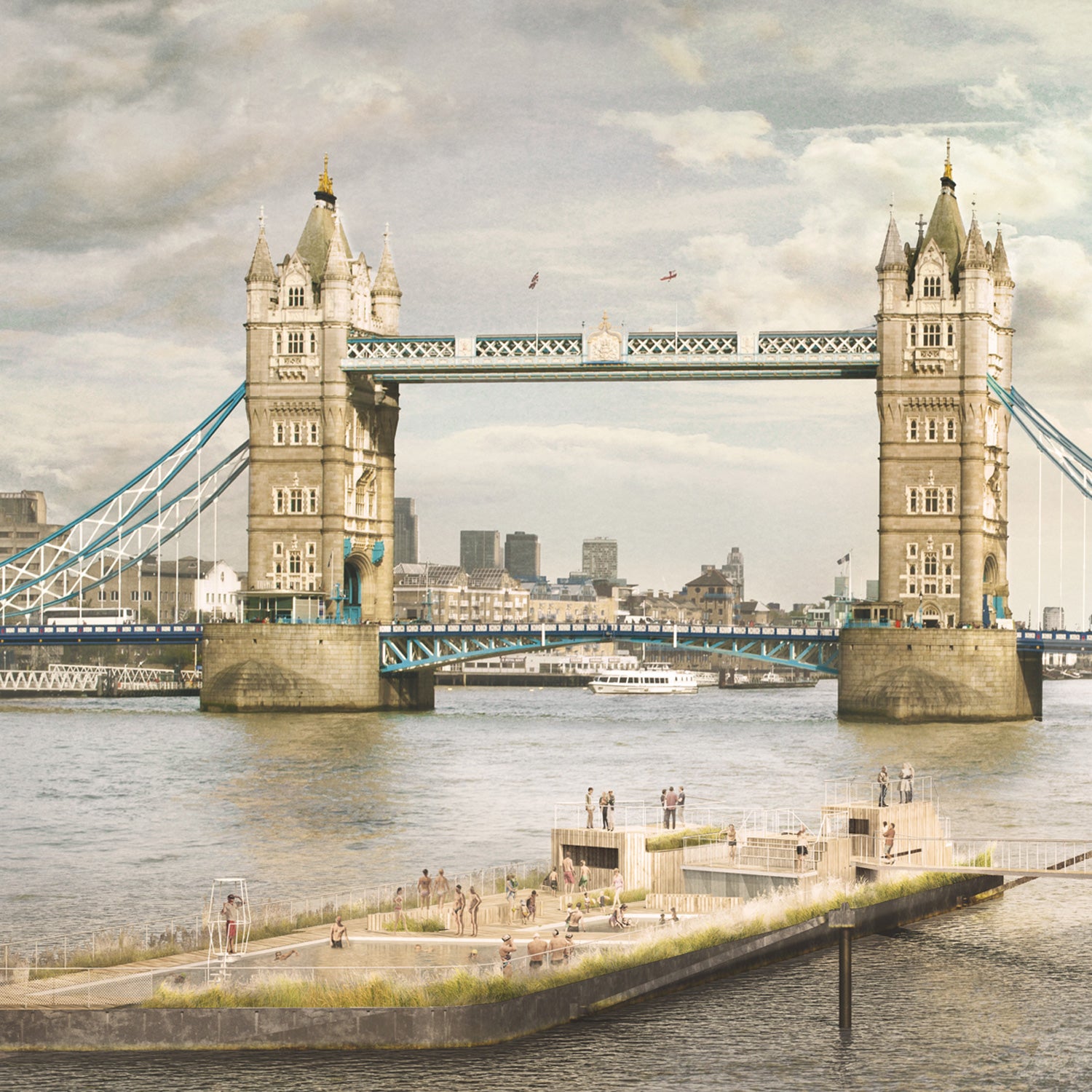British architect Chris Romer-lee was on holiday in Zurich in 2013 when he had an epiphany. Or, rather, a pang of envy. “I couldn’t believe you could , which is right in the middle of the city center,” Romer-lee says. “There’s a whole series of public baths on the edge of the lake, and then you just enter the lake. It’s like a natural swimming pool.”
Not long after that trip, UK nonprofit the and London’s Royal Academy of Arts organized soliciting visions for the future of the Thames River in London. Romer-lee and his partners at his firm knew exactly what to do.��“We presented a utopian vision of swimming in the Thames,” he says. The idea—for floating pools of natural Thames water—was one of five selected to present to a panel of advisors and to the public. “That led to , which was a spectacular success.”
Dubbed the Lido and launched on April 22, 2015, the project was fully funded a month later, with 1,273 backers pledging a total of about $221,000. “Our rewards were memberships to a pool which hasn’t been built,” Romer-lee says. The investment—despite the lack of an immediate reward—shows how “people really want to be a part of it.”
The Kickstarter campaign catapulted the Thames Baths into global consciousness, and as the media and other architects took notice, Romer-lee realized he was not alone in his desire to reclaim city waterways for recreation. In fact, he’s not alone in designing floating pools that naturally filter city river water either; the swimming hole is fast becoming the modern metropolis’s new must-have.
Architects from a New York City firm called , for example, have launched successful raising more than $313,000 for a similar project called . In Berlin, design firm realities:united is championing , or river pool, a project that would turn into a naturally filtered oasis. The raised $33,768 last January to bring a naturally filtered watering hole there. And in Portland, a group called the is working to get more and better access to the Willamette River.��
The idea of swimming in several of these cities is hardly new. “In the ‘40s and ‘50s, people did swim in London,” says Kate Rew, founder of , a group that promotes “wild swimming,” or swimming in nature. “Then somebody invented indoor swimming pools, which were simple, safe. People got estranged from natural temperatures. And there was a period of industrial pollution where rivers” were contaminated, she says. So as cities like London grew, their designs did not include recreational access to the dirty water.
In Portland, Terence O’Donnell and Thomas Vaughan write in their 1976 book, , which is excerpted on the Human Access Project’s website, people didn’t even want access because the water was so filthy.
From the beginning, the city’s water playground had also been the city’s sewer. Boat clubs declined the use of the river as did swimmers, lovers, fishermen and boys in skiffs…Finally, in 1929 the downtown wharves were demolished and a seawall was built. The Willamette became a ditch and almost entirely disappeared from the city’s consciousness.
Large-scale efforts to clean city waterways is a big reason so many people are trying to bring back swimming. The European Union, for example, has enacted that are forcing cities like London to . London has started to upgrade its sewer system, which consistently leaked raw sewage into the Thames, in a called the . “Now the river is a lot cleaner than it has been,” Romer-lee says.
New York’s , a project started in 2009, has been heralded as a success for removing toxins from the river. “Now towns along New York's upper Hudson have begun revitalizing these old industrial waterfronts, thinking about a future where kids can swim and play along the shore without fear of contamination,” .��
There’s also the simple desire to connect with nature. “Life in a big city like New York is much different than living in California or Colorado,” says NYC’s Plus Pool architect, Dong-Ping Wong, who grew up surfing in San Diego. In the big city, it takes planning or a weekend trip to get in touch with the environment, he says. “The river is such a huge resource. It’s just a natural progression to get back into the water.”
And there’s a spiritual aspect to it. “You go for a run or a walk and you feel good afterward,” Rew says. “But swimming’s got a turbocharge from being free of gravity that makes it much more transcendent than other forms of exercising in nature.”
Though several of the proposed projects face regulatory hurdles before they’re fully realized—Romer-lee estimates the Thames Baths won’t be made until at least 2017, while getting NYC to sign off on the Plus Pool could take until 2019—they have so many positive qualities, their champions can’t imagine the plans won’t get approved. “It’s not just about building something really really amazing on the river,” Romer-lee says. “It’s about solving problems.”
Indeed, several cities have already opened natural swimming spaces—some for decades. Vienna has its , the result of a flood-control project started in the 1970s, for example, and opened in 1992. More recently, Copenhagen welcomed , a natural water park completed in the city’s harbor in 2013 that strongly resembles what Romer-lee is trying to achieve. The project, which used two triangular boardwalks to enclose swimming areas, won for reuniting the city with its harbor.
The architecture itself, in many of the urban swim projects currently proposed, contributes to the health of the waterways and their ecosystems by using wetlands to help filter the water and create wildlife refuges. “So there’s a good environmental quality to it,” Romer-lee says. And there’s an educational aspect. “Kids can come to the river and learn about what we’re doing and why we’re doing it,” he says.��
From a human health and wellbeing point of view, the projects offer people a new public space and way to connect in nature. And then, of course, there’s the opportunity to swim. An urban swim project like Romer-lee’s Thames Baths “ticks so many boxes it’s tough to argue against it,” he says.


